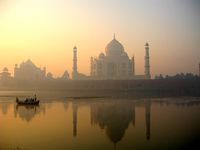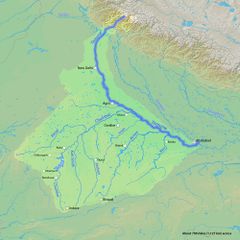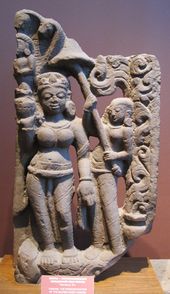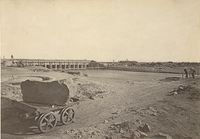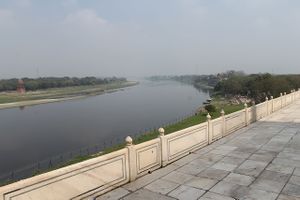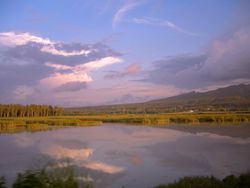يامونا
| يـَمـُنا Yamuna | |
| River | |
| البلد | الهند |
|---|---|
| States | Uttarakhand, Uttar Pradesh, هاريانا, دلهي |
| الروافد | |
| - يسار | Hindon, Sharda, Kunta, Gir[بحاجة لتوضيح], Rishiganga, Hanuman Ganga, Sasur Khaderi, Tons |
| - يمين | Chambal, Betwa, Ken, السند, Dhansan |
| المدن | يمنا نگر, دلهي, Mathura, أگرا, Etawah, Kalpi, الله آباد |
| Source | يامونوتري |
| - الموقع | Banderpooch peaks, Uttarkashi district, Uttarakhand, الهند |
| - elevation | 3،293 m (10،804 ft) |
| - coordinates | 31°01′0.12″N 78°27′0″E / 31.0167000°N 78.45000°E |
| المصب | Triveni sangam |
| - الموقع | الله آباد, الهند |
| - الارتفاع | 74 m (243 ft) |
| - الاحداثيات | 25°25′11.44″N 81°53′5.80″E / 25.4198444°N 81.8849444°E |
| الطول | 1،376 km (855 mi) |
| الحوض | 366،223 km2 (141،399 sq mi) |
| التدفق | المصب |
| - المتوسط | 2،950 m3/s (104،178 cu ft/s) [1] |
Map
| |
يـَمـُنا أو يامونا (/jəmʊnaː/؛ بالسنسكريتية وبالهندي: यमुना ؛ إنگليزية: Yamuna)، وأحياناً يسمى جمنا (بالهندي: जमुना؛ /d͡ʒəmʊna:/ ؛ إنگليزية: Jamuna) هو أطول وثاني أكبر نهر رافد لنهر الگنج (گانگا) في شمال الهند. وينبع من مثلجة يامونوتري على ارتفاع 6,387 متر على المنحدرات الجنوبية الغربية لقمم بندرپوچ في أعلى منطقة في الهيمالايا السفلى في Uttarakhand, it travels a total length of 1،376 كيلومتر (855 mi) and has a drainage system of 366،223 متر كيلومربع (141،399 sq mi), 40.2% of the entire Ganges Basin, before merging with the Ganges at Triveni Sangam, الله آباد، موقع احتفال كومبا ملا كل اثنتي عشر عاماً.
It crosses several states, Uttarakhand, Haryana and Uttar Pradesh, passing by Uttarakhand and later Delhi, and meets its tributaries on the way, including Tons, its largest and longest tributary in Uttarakhand, Chambal, which has its own large basin, followed by Sindh, the Betwa, and Ken. Most importantly it creates the highly fertile alluvial, Yamuna-Ganges Doab region between itself and the Ganges in the Indo-Gangetic plain. Nearly 57 million people depend on the Yamuna waters. With an annual flow of about 10,000 cubic billion metres (cbm) and usage of 4,400 cbm (of which irrigation constitutes 96 per cent), the river accounts for more than 70 per cent of Delhi’s water supplies. Just like the Ganges, the Yamuna too is highly venerated in Hinduism and worshipped as goddess Yamuna, throughout its course. In Hindu mythology, she is the daughter of Sun God, Surya, and sister of Yama, the God of Death, hence also known as Yami and according to popular legends, bathing in its sacred waters frees one from the torments of death.[2][3]
The water of Yamuna is of "reasonably good quality" through its length from Yamunotri in the Himalayas to Wazirabad in Delhi, about 375 كيلومتر (233 mi), where the discharge of waste water through 15 drains between Wazirabad barrage and Okhla barrage renders the river severely polluted after Wazirabad. One official describes the river as a "sewage drain" with biochemical oxygen demand (BOD) values ranging from 14 to 28 mg/l and high coliform content.[4] There are three main sources of pollution in the river, namely households and municipal disposal sites, soil erosion resulting from deforestation occurring to make way for agriculture along with resulting chemical wash-off from fertilizers, herbicides, and pesticides and run-off from commercial activity and industrial sites.
مسار النهر

| الولاية | مساحة التجميع (كم²) | % من حوض التجميع |
|---|---|---|
| أتر پرادش وأوتاراخند | 74,208 | 21.5 % |
| هيماچل پرادش | 5,799 | 1.6 |
| هاريانا | 21,265 | 6.5 |
| راجستان | 102,883 | 29.8 |
| ماديا پرادش | 14,023 | 40.6 |
| دلهي | 1,485 | 0.4 |

التاريخ
الأهمية الدينية
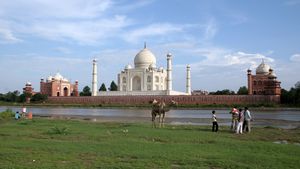
ادارة النهر
الري
الجغرافيا والحياة البرية
The catchment area of the river, especially till it touches the plains, is replete with alpine, semi alpine, temperate and sub-tropical vegetation, and vast areas are under forest cover, and supports extensive animal life.
Yamuna is the frontier of the Asian Elephant. West of the Yamuna, there are no elephants to be found over 900 كيلومتر (560 mi) of the western Himalayas and their foothills. The forests of the lower Yamuna offer ideal corridors for elephant movement. The principal forests to be found here are of sal, khair (acacia), and sissoo (rosewood) trees, and the Chir Pine forests of the Shivalik Hills.
التلوث
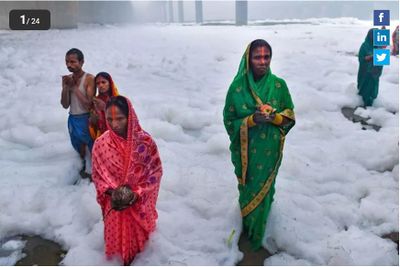
معرض صور
انظر أيضاً
للاستزادة
- Fraser, James Baillie (1820). Journal of a tour through part of the snowy range of the Himala Mountains, and to the sources of the rivers Jumna and Ganges. Rodwell and Martin, London.
- Haberman, David L. (2006). River of love in an age of pollution: the Yamuna River of northern India. University of California Press. ISBN 0-520-24790-6.
- Schumann, A. H. (2001). Sustainable regional water management of Yamuna river basin: A case study. International Association of Hydrological Sciences(IAHS). pp. 25–32. ISBN 1-901502-51-1.
الهامش
- ^ Jain, Sharad K.; Agarwal, Pushpendra K.; Singh, Vijay P. (2007). Hydrology and water resources of India. Springer. p. 341. ISBN 978-1-4020-5179-1. Retrieved 26 April 2011.
- ^ Jain, Sharad K.; Pushpendra K. Agarwal; Vijay P. Singh (2007). Hydrology and water resources of India- Volume 57 of Water science and technology library. Springer. pp. 344–354. ISBN 1-4020-5179-4.
- ^ Hoiberg, Dale (2000). Students' Britannica India, Volumes 1-5. Popular Prakashan. pp. 290–291. ISBN 0-85229-760-2.
- ^ "'Ganga is the most polluted river'". The Hindu. Nov 23, 2003.
وصلات خارجية
- Articles with links needing disambiguation from March 2014
- صفحات المعرفة التي فيها البلد أو التقسيم غير معروف
- Pages using gadget WikiMiniAtlas
- Pages using deprecated coordinates format
- Pages using geobox2 unit with unknown unit type
- Geobox usage tracking for river type
- Articles containing إنگليزية-language text
- Pages using Lang-xx templates
- Articles with hatnote templates targeting a nonexistent page
- نهر يامونا
- أنهار ريگڤيدية
- أنهار دلهي
- أنهار هاريانا
- أنهار اوتر پرادش
- أنهار اوتاراخند
- أنهار مقدسة
- إلهات البحار والأنهار
- روافد الگنج
- أنهار الهند
